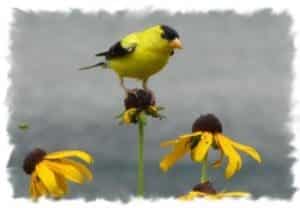8 Ways to Help Birds

American Goldfinch
Photo by Jim Martin
by Val Cunningham
Contributing Writer
A brand-new year lies ahead, full of possibilities and opportunities. Here are some suggestions for ways to help the birds (and other flying things) that bring such beauty and joy to our lives.
1. For starters, let’s not accept a single incident of death or injury to birds through flying into our windows. This is not natural, birds hit glass because windows are invisible to them, so it’s our job to make the glass more visible. You needn’t add protection to every pane in your home, only those hit by a bird in the past, and/or the window that’s closest to your feeders. UV-reflecting window decals, nearly invisible to us but like neon signs to birds, do the job well (See them at wild bird supply stores or online).
2. Can’t stress this enough: Keep your cat indoors, because all cats that roam outdoors kill birds, hundreds of millions of them each year. If neighborhood cats use your yard, protect birds by placing fencing (at least 3-ft. high and in a wide circle) around the birdbath and underneath feeders. This protects birds when their attention is focused on bathing and feeding on the ground. And feel free to spray those unwelcome cats with the garden hose.
Mini-wildlife refuges
3. Begin viewing your backyard as a refuge for wildlife. Start small by planting some flowering native plants and maybe a native shrub. The following year, add a few more and you’ll soon be pleasantly surprised by the many new butterflies, bumble bees and solitary bees flitting from plant to plant and birds feeding on nature’ bounty—insect larvae and natural seeds and berries.
4. If you can, plant a tree, since trees are so vital for birds and we’re losing so many to disease. There are small trees (pagoda dogwood and serviceberry), medium-sized trees (river birch and blue beech) and big trees (hackberry and oak) to fit any situation. Native trees have high value to birds, who feed on caterpillars high in the canopy in the spring, nest in them in summer, and then enjoy the fruit or nuts when they ripen. Trees are a gift to ourselves and to future generations.
5. Let’s step up this bird-feeding business by keeping feeders clean and filled with seed. Check them after any rain- or snowstorm and toss out any wet seed to avoid disease. Wash feeders at least every couple months, so they don’t become sources of infection (scrub well, rinse in 1 part bleach/9 parts water, and rinse again thoroughly). A good tip: Maintain several small feeders, and replenish the seed each day, thereby insuring that it’s fresh.
Poison-free landscapes
6. Let’s vow to make this the year that we stop poisoning our landscapes. Seriously, broad-spectrum pesticides are lethal to insects, and this includes bees, butterflies and beneficials like lady beetles and praying mantis. Let nature take its course: bigger insects eat smaller ones, and birds consume insect larvae. Watch carefully to make sure you’re not buying plant stock that’s been “pre-poisoned” by a new class of insecticides known as neonicotinoids. These chemicals spread throughout a plant and have an adverse impact on honeybees, butterflies and even birds. Ask about this before you buy plants.
7. Give birds the gift of a reliable supply of water for bathing and drinking year ‘round by installing a heater in the winter months. Winter and summer, hose out the bath basin daily and enjoy the crowd of birds eager to refresh themselves.
8. Look beyond the backyard and join an organization dedicated to preserving the natural world, a list that includes the Audubon Society, the Sierra Club and Friends of the Mississippi. We need more voices speaking up for nature.
And how about volunteering at your local nature center, nearby state park or wildlife refuge to help introduce kids and others to the wonders of nature?
These are just some ideas for putting good intentions into practice in the coming year.
St. Paul, Minn., resident Val Cunningham, who leads bird hikes for the St. Paul Audubon Society and writes about nature for local, regional and national newspapers and magazines.



